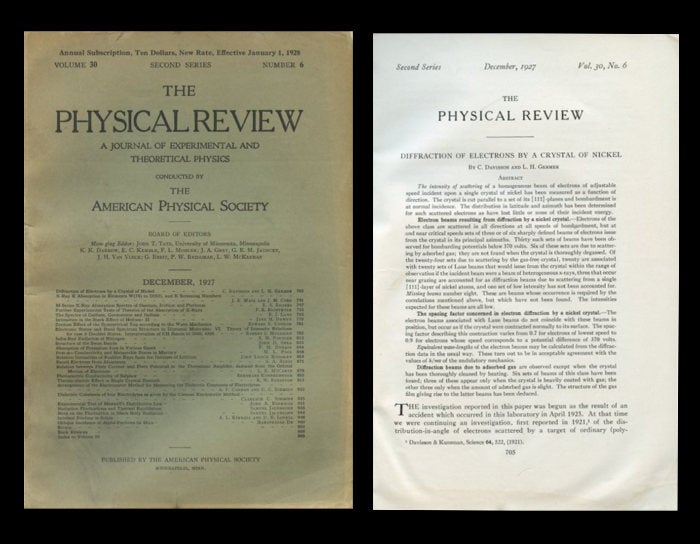The Diffraction of Electrons by a Crystal of Nickel in The Physical Review, Vol. 30, No. 6, December 1927, pp. 705-741
Minneapolis: American Physical Society, 1927. 1st Edition. FIRST EDITION IN ORIGINAL WRAPS of Davisson and Germer's famous 1927 experiment confirming de Broglie's hypothesis on matter waves, a key pillar of the emerging theories of quantum mechanics.
The Davisson-Germer experiment demonstrated the wave-like nature of electrons by showing that they could be diffracted by a nickel crystal, and in so doing, provided important experimental support for de Broglie's theory of 'matter waves,' Bohr's theory of complementarity and Schrodinger's theory of wave mechanics. Their experiment did not begin as a test of the wave theory. They 'were studying the surface of a piece of metallic nickel by bombarding it with electrons, and observing how many electrons were scattered at various angles. During the experiment an accident occurred. Air entered the vacuum tube containing the nickel target, so that an oxide film formed on its surface. To reduce the oxide on the target the two experimenters heated the nickel to high temperatures. The effect of this was that large crystals were formed in the metal.
When they repeated the experiment they obtained quite different results. Peaks in the intensity of the reflected electrons occurred at specific angles, in contrast to what they had observed before the accident. They immediately noticed the similarity of this behavior to the diffraction of X-rays by crystals. It was thus that Davisson and Germer discovered electron waves" (Dardo, Nobel Laureates and Twentieth-Century Physics, 197-198). The wave nature of the electron had been established.
In April of the same year, 1927, Davisson and Germer published a small and very cautious announcement of their findings in Nature. The Physical Review paper is lengthy and is "a detailed, comprehensive report on experiments performed, conclusions reached and questions left unanswered. One of the significant features of the paper was its thoughtful examination of the possible ways of interpreting the systematic differences between observed and calculated electron wavelengths" (Physics Today, January 1978, 40). Their writing makes clear that between the March announcement in Nature and April when the Physical Review abstract was first prepared, they had "already gone beyond the point of using the 'known' structure of the nickel crystal to find out about the possibility of the wave properties of the electron: they were now using the 'known' electron waves to learn new facts about the nickel crystal" (Physics Today, 39). Davisson and Germer showed that waves are not simply mathematical conveniences, but have observable physical effects. Just as Compton showed that waves could act like particles, Davisson and Germer showed that particles could act as waves. Compton's work, together with that of Davisson and Germer established the wave particle duality hypothesis so fundamental to quantum theory. Item #397
CONDITION & DETAILS: Minneapolis: American Physical Society. The Physical Review, Vol. 30, No. 6, December 1927, pp. 705-741. Quarto (10 x 7 inches; 250 x 175mm). The original wraps are toned and faded, more so at the edges. There is chipping with minor loss at the head of the spine and a small corner of the lower left rear wrap is missing; slight crease at the center foot of the textblock. There is a very, very slight stain at the foot of about three quarter of the pages, but one does have to look carefully to see it. Withal, the issue remains tightly and solidly bound.
Price: $1,000.00

